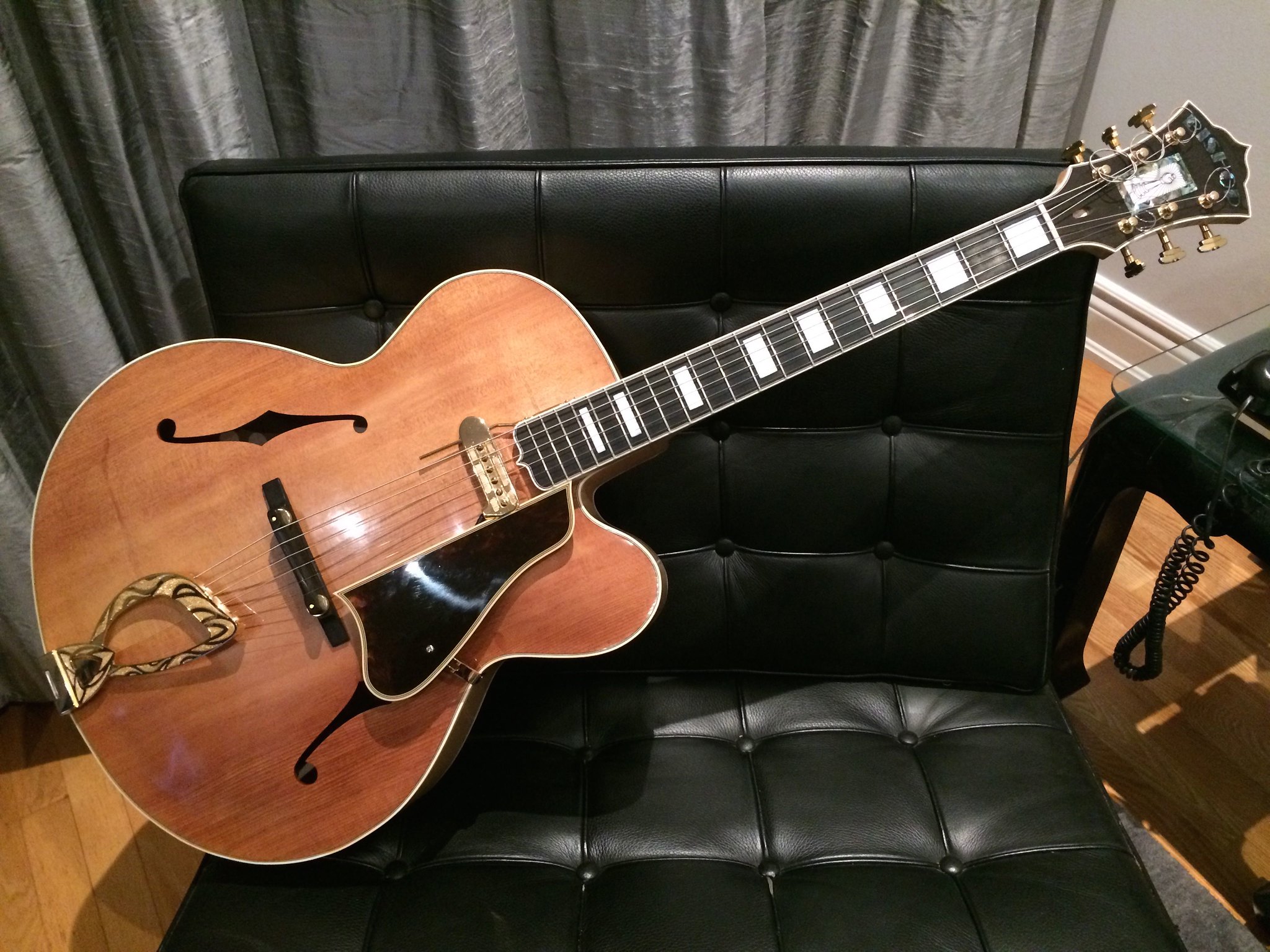-
They're doing amazing things with 3D printers these days. Or they're writing songs of love. Or something like that.
I spent some time with my pal Ben Bishop, a fan of nice archtop guitars and a wonderful jazz musician, playing his very new 17" archtop guitar, and thought I'd post a few quicky pix, with his blessing. I think that some of you are interested in such things. Better shots to come soon enough.
The phrase "in the tradition" comes to mind. Anyway, it was refreshing to play a guitar specifically built to generate as much acoustic sound as possible. And the operation was a success. It sounds great. It plays great.
Specs are essentially Johnny Smith, but with 3 1/4" rims and a shellac finish. Plenty of decorative cues from some classic instruments. A few small bits to be adjusterated. Not yet-another trendy version of a 16" L-5. More on this to come, but ... wow. This really made my day, and no unlucky punks were involved.





Last edited by Hammertone; 04-18-2021 at 02:10 PM.
-
09-11-2020 04:04 AM
-
Very nice! Would love to hear it.
-
-
What did 3D printing have to do with the guitar. You glossed over that fact. I dig the look. Touches from a Guild, and an L5. Gorgeous result!
-
The old school method of instrument-building requires a lot of work: rough-carving front and back plates; planing, scraping, and sanding the graduated plates to get them to be the right arch and thicknesses; installing the top bracing; tuning the plates, and so forth. Rims need to be thicknessed, steam-bent and so forth. Necks need to be glued up, rough-carved, then hand-carved to just the right size, shape and feel. After the box is glued up, the recarve needs to be worked on some more. Even with the help of various machines and jigs, that is a lot of work, and the fine scraping and sanding to get the plates and the neck just right are quite time-consuming. Some particularly gifted luthiers have a real feel for the wood and are able to build remarkably responsive acoustic instruments. It requires talent and hard work. It requires full immersion into the world of the wood.
Now, all one needs to do is program all of that into the 3D printer and - presto! - a remarkably responsive acoustic archtop guitar like this one appears. Hey! Wait a minute...Last edited by Hammertone; 04-18-2021 at 02:12 PM.
-
Damn, that archtop looks gorgeous! It looks typically 70’s Guild. But with a Cupid’s bow like it should have!
-
I dig your wordage, Dude !

-
That's very attractive. Very much a Johnny Smith style instrument. Sort of a cross between the Guild and Gibson models.
Sent from my SGH-I337M using Tapatalk
-
And it weighs half as much as a typically '70s Guild AA Panzer.
 Originally Posted by 2bornot2bop
Originally Posted by 2bornot2bop
-
Hey guys, I don't come on the forum too often but, since I find myself here now, I thought you might be interested in hearing what this "Bishop" guitar sounds like. I'm really knocked out by the results of this build and I have to thank my good pal fritz_jones78 (IG handle) for working with me to realize exactly what I wanted in an instrument. I'm a picky sonuvabitch as Hammertone knows all too well.
-
Nice balance, love the Guild tailpiece.
-
The amplified tone is nice but as always : which type/model amp was used, how was it mic'd up, how loud did you play ?
 Originally Posted by PopeoftheES-175
Originally Posted by PopeoftheES-175
I'd really be much more interested in the pure acoustic tone but I also realize that it's quite a challenge to get that on tape
in such a fashion that the listener can truly get an idea about the tonal character, the dynamic range and such...
Did you use flat- or roundwound strings ?
I often find that roundwounds sound too harsh and wiry on archtops (when played more softly, single notes, chord solo's etc.) and flats often lack
the definition, the string-to-string balance and the sustain I'd like to have... the best results in that regard I've had with light gauge Elixir strings : these on my
all-mahogany (hog top also) Santa Cruz 000-1929 sound really sweet, with no exaggerated overtones, a SOLID fundamental tone, excellent sustain and a beautiful overall balance. I wonder how a set of med. coated bronze strings would sound on a nicely carved archtop ....
-
I used Black Diamond flats in 13-56 on the guitar and was playing it through a mid '60s Ampeg Gemini I amplifier with a JBL D131 speaker. We're an organ trio with a real Hammond/Leslie setup so that should give you some idea of what the volume level was. I have no idea about the microphone used although I'm pretty certain this was the usual close mic type setup with a typical dynamic microphone such as a Shure SM57. To my ears, there was a little more sparkle in the actual guitar sound than the recording conveys. I dig in pretty hard when I pick and I was using a big triangle Fender Tru-Shell pick in medium gauge. The pickup is a reissue Dearmond model 1100 and it's currently wired up direct to the output jack with no controls.
-
I should also mention that Hammertone deserves a major assist for offering his advice regarding many aesthetic details, for supplying me with some of the hardware, and for helping me to realize the headstock shape and chess piece graphic.
-
Those Johnny Smith models were unquestionably the main inspiration for this instrument. The neck profile is a wide D much like one of those early Smiths, in particular a '62 Gibson Johnny Smith that I played at a guitar show a couple years back, at which point I realized how much I liked a wide and flat neck.
 Originally Posted by Kirk1701
Originally Posted by Kirk1701
Last edited by PopeoftheES-175; 04-18-2021 at 05:52 PM.
-
I owe it all to the chair. All hail the chair!
 Originally Posted by PopeoftheES-175
Originally Posted by PopeoftheES-175
-
 Originally Posted by PopeoftheES-175
Originally Posted by PopeoftheES-175

Absolutely scrumptious instrument! Congratulations, and play it in good health!
-
Wait, so back to the printer...
the 3D printer...squirted out wood? Carved the wood? Squirted out plastic that looks like wood?
-
Easy peasy. You hook it up to blockchain.
 Originally Posted by 6v6ster
Originally Posted by 6v6ster
There are synergies.
-
It squirts out wordplay, bad jokes and a bit of irony.
 Originally Posted by 6v6ster
Originally Posted by 6v6ster
-
I just tried to imagine what a guitar designed by Ludwig Mies van der Rohe would look like .... probably something with lots of chrome, maybe some black marble and very few knobs, if any
 Originally Posted by Hammertone
Originally Posted by Hammertone

As a classic design piece I find these chairs absolutely beautiful and unsurpassed but having owned a pair I can only attest that they are not the most comfortable chairs to rest in for more than
half an hour ... it's no wonder that one often finds these in the lobbies of posh banks, Insurance corporations and the like - where they don't want people to get too cozy.
-
Regarding the chair, Albert Pfeiffer (Vice President of Design and Management at Knoll) commented in 1997 on Mies and his personal and professional design partner, Lilly Reich:
"It became more than a coincidence that Mies's involvement and success in exhibition design began at the same time as his personal relationship with Reich... It is interesting to note that Mies did not fully develop any contemporary furniture successfully before or after his collaboration with Reich."




 Reply With Quote
Reply With Quote








2 new & excellent Jazz Comping Truefire...
Yesterday, 10:22 PM in Comping, Chords & Chord Progressions